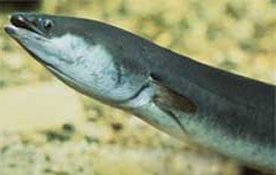 I have been asked on a number of ocasions now how can you tell the differencs between the eels, hopefully after reading this you will be able to tell.
I have been asked on a number of ocasions now how can you tell the differencs between the eels, hopefully after reading this you will be able to tell.
I have added freshwater eels to this site because though they reside in fresh water, they as adults, migrate to the sea to breed.
There are two freshwater eels in New Zealand, both being similer to look at. They are the.....
- Shortfinned eel: (Anguilla australis)
- Longfinned eel: (Anguilla dieffenbachii)
You have to look at both of these fish very closely to tell them appart.
The longfin eel lives throught the whole country and nowhere else, where as the shortfin also can be found in parts of Australia and some Pacific islands.
The shotfin are a dark grey greeny, or golden olive colour above and a pailer white below, and the longfin are a dark brown to greyish colour above and slightly pailer below.
On the shortfinned eel, looking side on the dorsal fin does not extend much further forward than the anal fin. The dorsal fin on the longfinned eel extends a little further. ( you realy have to look at the two together) to notice this.
Having a close look at the heads though on the longfin eel the mouth is larger and extends back behind the eye. On the shortfin the mouth is smaller and stops just below the eye.
Shortfin males are around 40 to 50 cm long and females 50 to 80 cm long. The longfin male eels are around 50 to 70 cm and the females are around 80 to 120 cm long.
The life cycle of both species are much the same. The shortfin eels are most common in ponds, lakes and swamps. And the longfin tend to live further inland in streems and rivers.
The shortfin males also tend to live in slightly more brackish waters.
Both species tend to feed on small aquatic insects, though the larger ones particulary the longfin females may eat smaller fish.
Both species will feed on dead animal carcases such as possoms, sheep and goats etc.
Both species are slow to grow and may live for up to forty to sixty years.
Both species will migrate to the sea to spawn where the eggs hatch into a transparent larve. These drift in the oceans currents for a time ( I dont know how long) then as small eels, upon reaching the coast line enter the fresh water streems and swimm upstream. (I once experienced this return to the streems at Ahipara one night, when entering the creek it became alive with thousands of small eels returning).
I must confess I have never seen a freshwater eel in the sea.